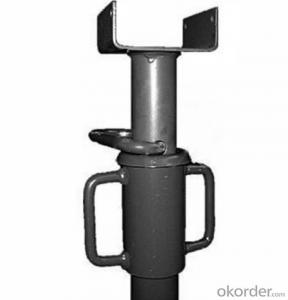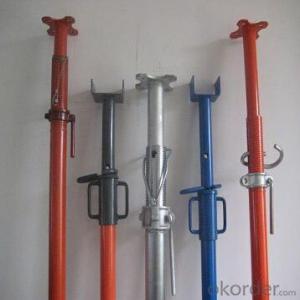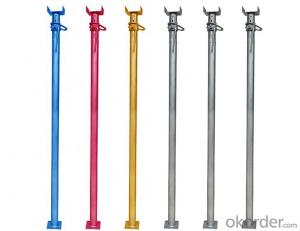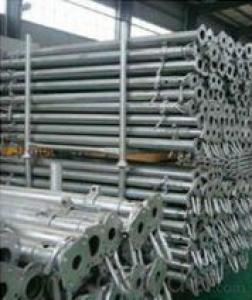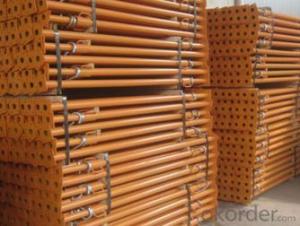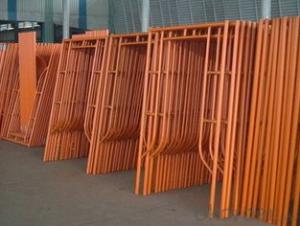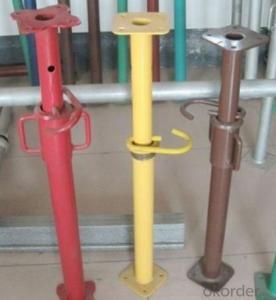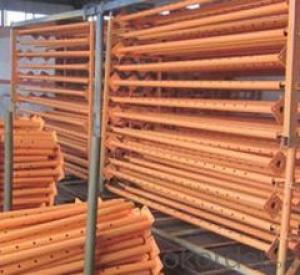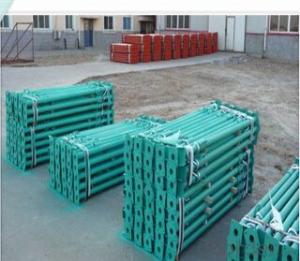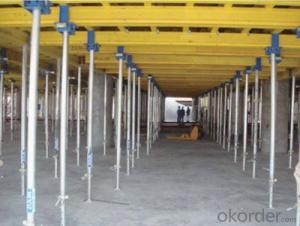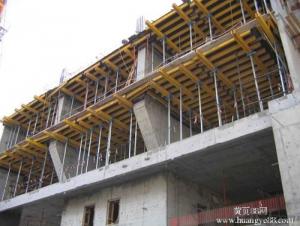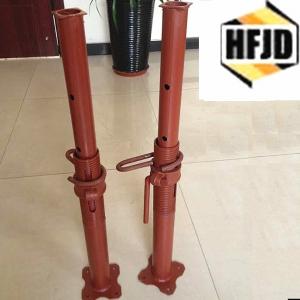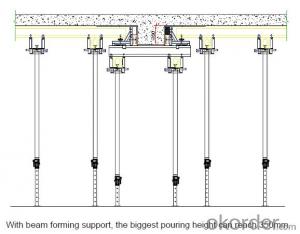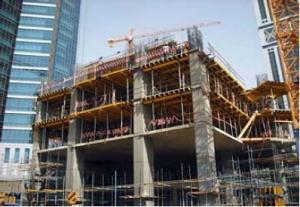Heavy duty construction concrete wall steel props
- Loading Port:
- Tianjin
- Payment Terms:
- TT OR LC
- Min Order Qty:
- 10000 PCS
- Supply Capability:
- 10000 PCS/month
OKorder Service Pledge
OKorder Financial Service
You Might Also Like
Quick Details
| Model Number: | steel props | ||||
| material: | steel | color: | silver,dark red,yellow,blue,green | surface treatment: | dip painted,power coated,galvanized |
| Product type: | steel props | Application: | building construction for inside concrete wall support | support capacity: | 1.5-4tons |
| Working life: | 4-6 years normally | inner tube diameter: | 40mm,or 48mm | outer tube diameter: | 48mm,or 56/58/60mm |
| base plate size: | 120*120*4.75mm |
Packaging & Delivery
| Packaging Detail: | steel props packing: in bulk, in bundle, in steel pallet, or as your request. one 20ft container can load about 1500-2600 pieces, depends on the expected size. |
| Delivery Detail: | 10-30 days after order confirmation |
Specifications
steel props
1)Manufacturer 10 years;
2)OEM offered;
3)Formwork,beam,concrete,slab support;
4)Promptly delivery.
Name | steel props |
Surface Treatment | Galvanized,powder coated,dip painted |
Extension length | 1600-2900/1800-3200/2000-3600/2200-4000mm or customed |
Certificate | SGS test report for loading capacity |
Service | OEM Service available |
MOQ | one 20ft Pcontainer,about2000pcs |
Payment | T/T.L/C |
Delivery Time | About 10-30 days after confirmation |
Packing | in bulk ,in bundle, in steel pallet or as your request |
production capability | 200tons per day |
- Q: How do you install and set up a steel prop?
- To install and set up a steel prop, follow these steps: 1. Determine the appropriate location: Assess the area where the steel prop will be installed. Ensure the ground is stable and capable of supporting the prop's weight. 2. Select the right prop: Choose a steel prop that matches the required load capacity. Consider factors such as the height and weight it needs to support. 3. Prepare the area: Clear the installation site of any debris or obstacles. Ensure there are no underground utilities or cables that could be damaged during the installation process. 4. Position the prop: Place the prop in the desired location, making sure it is aligned vertically. Adjust the prop's height according to the required level or support needed. 5. Secure the prop: Use a spirit level to ensure the prop is perfectly vertical. Use a steel prop clamp to secure it in place. Make sure the clamp is tightened securely to prevent any movement. 6. Adjust the height: If necessary, adjust the height of the steel prop to meet the required specifications. This can be done by extending or shortening the prop's telescopic sections. 7. Support the load: Once the prop is securely in place, ensure it is supporting the intended load. Double-check the weight capacity and make sure it is not being exceeded. 8. Regular inspections: Periodically inspect the steel prop to ensure it remains secure and properly aligned. Look for any signs of damage or movement. If any issues are detected, take immediate action to rectify them. Remember to always follow the manufacturer's instructions for the specific steel prop being used. If in doubt, consult a professional or seek expert advice to ensure proper installation and set up of the prop.
- Q: How do steel props contribute to the stability of excavation trenches?
- Maintaining the stability of excavation trenches requires the use of steel props. These props, which come in the form of adjustable metal tubes, play a vital role in supporting the surrounding walls of the trench and ensuring the safety of workers. One way in which steel props contribute to stability is by exerting pressure on the trench walls. Carefully positioned along the length of the excavation, these props can be adjusted to provide precise support at different heights. By pushing against the walls, they counteract lateral forces and prevent collapse, thereby preserving the shape and integrity of the trench, even in unstable soil conditions. Furthermore, steel props add structural reinforcement to the trench. Acting as vertical columns, they bear the weight of the soil and any additional loads imposed on the excavation. This reinforcement enhances trench stability, reducing the risk of wall failure and ensuring worker safety. In addition, steel props can be combined with other support systems, such as timber boards or sheet piles, to create a comprehensive safety structure. Together, these systems work in harmony to provide a stable and secure environment for excavation activities. Moreover, steel props offer flexibility during the construction process. Their adjustable nature allows for easy adaptation to changing conditions, such as varying trench depths or different soil types. As the excavation progresses, the props can be repositioned or extended to meet evolving requirements, ensuring continuous stability throughout the project. In conclusion, steel props are indispensable in maintaining the stability of excavation trenches. Through exerting pressure, providing structural reinforcement, offering flexibility, and collaborating with other support systems, these props create a safe and secure working environment, preventing collapse and ensuring the success of excavation projects.
- Q: Can steel props be used for supporting precast concrete elements?
- Yes, steel props can be used for supporting precast concrete elements. Steel props, also known as adjustable props or scaffolding props, are commonly used in construction to provide temporary support for various types of structures, including precast concrete elements. Precast concrete elements, such as walls, beams, and slabs, are manufactured off-site and then transported to the construction site for installation. During the installation process, steel props can be used to provide additional support and stability to these precast elements. Steel props are designed to be adjustable in height, allowing them to accommodate different sizes and weights of precast concrete elements. They are also capable of withstanding heavy loads, making them suitable for supporting the weight of these elements during installation. Furthermore, steel props are easy to assemble and disassemble, making them a convenient and efficient choice for supporting precast concrete elements. They can be easily adjusted and repositioned as needed, ensuring proper alignment and support during the installation process. Overall, steel props are a reliable and commonly used solution for supporting precast concrete elements. They provide temporary support and stability, allowing for safe and efficient installation of these elements in construction projects.
- Q: How do you check the integrity of a steel prop before use?
- To check the integrity of a steel prop before use, you should perform a thorough visual inspection and follow these steps: 1. Look for any visible signs of damage or defects such as cracks, dents, or bends in the steel prop. Pay close attention to stress points, joints, and connections as these areas are more susceptible to wear and tear. 2. Check the surface condition of the prop. Look for signs of corrosion, rust, or pitting, which can compromise the strength and stability of the prop. If the surface is heavily corroded, it may indicate a potential structural weakness. 3. Examine the adjustable mechanism of the prop. Ensure that all adjustment mechanisms, such as pins, bolts, and screw threads, are in good working condition and without any signs of wear or damage. Make sure they operate smoothly and securely lock into place. 4. Inspect the base or footplate of the prop. Ensure it is solid, stable, and free from any cracks or deformities. The base should be able to provide adequate support, especially on uneven or soft surfaces. 5. Use a straight edge or level to check the alignment and straightness of the prop. The prop should be straight and not have any visible bends or twists. Uneven or misaligned props can compromise their load-bearing capacity and stability. 6. If possible, conduct a load test by gradually applying weight or pressure to the prop to assess its strength. However, it is recommended to consult with a qualified engineer or follow manufacturer's guidelines for load testing procedures. 7. Finally, if you have any doubts about the integrity of the steel prop, it is advisable to consult with a structural engineer or a professional in the field. They can provide a more comprehensive inspection, conduct necessary tests, and determine if the prop is safe for use. Remember, ensuring the integrity of a steel prop is crucial for the safety of workers and the stability of any structure it supports.
- Q: Can steel props be used for temporary support in hydraulic structures?
- Yes, steel props can be used for temporary support in hydraulic structures. Steel props are strong and durable, making them suitable for providing temporary support during construction or repair work on hydraulic structures such as dams, bridges, or canals. Their adjustable height and load-bearing capacity make them a reliable choice for ensuring structural stability during temporary operations. However, it is important to consider the specific requirements and conditions of the hydraulic structure before using steel props to ensure their suitability and safety.
- Q: Can steel props be used in the construction of tunnels or underground railways?
- Yes, steel props can be used in the construction of tunnels or underground railways. Steel props are commonly used as temporary supports to provide stability and prevent collapse during excavation and construction processes in underground structures. They are durable, strong, and can be easily adjusted to support the desired load and dimensions of the tunnel or railway.
- Q: What are the main advantages of using lightweight steel props?
- There are several main advantages of using lightweight steel props in construction projects. Firstly, lightweight steel props offer a higher load capacity compared to traditional timber props. This means that they can support heavier loads, making them suitable for a wider range of applications. They are commonly used in building projects to support formwork, floors, and ceilings, providing stability and ensuring safety on site. Secondly, lightweight steel props are extremely versatile and adjustable. They can be easily extended or retracted to fit various heights, allowing for flexibility in construction projects where different floor heights or ceiling heights may be present. This adaptability makes them a cost-effective choice as they can be reused across multiple projects. Furthermore, lightweight steel props are durable and long-lasting. They are manufactured using high-quality materials that are resistant to corrosion and wear. This means they can withstand harsh weather conditions and are less likely to deteriorate over time, reducing the need for frequent replacements and maintenance. Another advantage of lightweight steel props is their ease of handling and transportation. Due to their lightweight nature, they are easier to carry and move around on site, reducing the physical strain on workers. Additionally, they can be quickly assembled and disassembled, saving time and labor costs during construction. Lastly, lightweight steel props offer enhanced safety on construction sites. Their robust construction and adjustable height features ensure stability and prevent accidents caused by collapsing structures. They also provide a more secure working environment for construction workers, minimizing the risk of injuries. In conclusion, the main advantages of using lightweight steel props in construction projects include their high load capacity, versatility, durability, ease of handling, and enhanced safety. These factors make them a preferred choice for many construction professionals, contributing to more efficient and successful building projects.
- Q: What are the components of a steel prop?
- The components of a steel prop typically include a steel tube or pipe, an adjustable threaded collar, a base plate or foot, and a swivel head or top plate.
- Q: Are steel props suitable for supporting formwork systems?
- Steel props are an appropriate choice for supporting formwork systems. In construction projects, steel props are frequently utilized to offer temporary support to formwork systems while concrete is being poured. Their adjustable height allows for flexibility in accommodating various formwork heights and load requirements. Not only are steel props robust and long-lasting, but they can also bear heavy loads, making them a dependable option for supporting formwork systems. Moreover, the ease of assembling and dismantling steel props makes them convenient for use on construction sites. In conclusion, steel props are widely regarded as a suitable choice for providing support to formwork systems in construction projects.
- Q: Can steel props be used in outdoor construction projects?
- Indeed, outdoor construction projects can make use of steel props. These props, commonly employed in construction, serve to support temporary loads, such as formwork, scaffolding, and shoring. Their design ensures versatility and durability, rendering them appropriate for outdoor applications. Typically fashioned from high-quality steel, steel props are crafted to withstand hefty loads and endure adverse weather conditions. With adjustable heights and easy assembly and disassembly, they prove convenient for outdoor endeavors. Within outdoor construction projects, steel props find utility in bolstering diverse structures like walls, slabs, beams, and columns. By delivering stability, they guarantee the security of the construction site. Moreover, steel props can be effortlessly secured in the ground or on concrete slabs, providing a dependable support system for construction activities. Moreover, steel props boast resistance to rust and corrosion, crucial attributes for outdoor use, where exposure to rain, sun, and other elements is likely. This durability ensures the structural integrity of the steel props throughout the construction project. In summary, steel props represent an exceptional choice for outdoor construction projects. Their strength, versatility, and durability qualify them for supporting temporary loads in a wide range of outdoor construction endeavors.
Send your message to us
Heavy duty construction concrete wall steel props
- Loading Port:
- Tianjin
- Payment Terms:
- TT OR LC
- Min Order Qty:
- 10000 PCS
- Supply Capability:
- 10000 PCS/month
OKorder Service Pledge
OKorder Financial Service
Similar products
Hot products
Hot Searches
Related keywords
